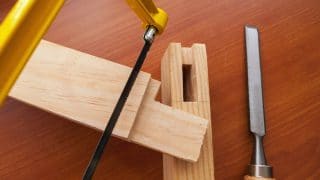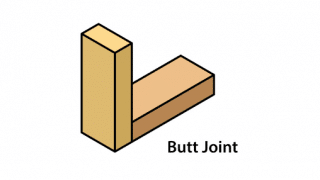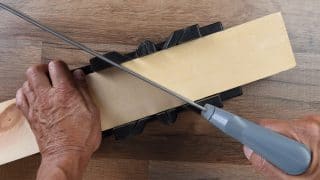

A dado joint, also sometimes referred to as a housing joint, is a very strong type of carpentry joint commonly across a variety of woodworking projects and especially cabinets and shelving. A dado cut creates a channel that runs along the length of a workpiece into which a coordinating piece is secured. Once combined, you have a dado joint that can be glued and nailed for an even sturdier finish.
What is a dado joint?
Dadoes and grooves are both defined as a three-sided channel cut into a workpiece but a dado is cut across the grain of the wood and a groove is cut parallel to the grain of the wood. The channel, often referred to as a dado cut, receives another piece of material measured and cut to fit snugly inside the channel. Dado joints are simple to make and one of the strongest types of joints that can handle the weight of heavy books, appliances, and tools.
Types of dado joints
There are a few different types of dado joints based on where the dado cut is made and how far it continues through the wood. The type of woodworking joints you choose will impact the finished look and the strength of the joint so consider where the cabinet or shelf will be installed and whether it will need to hold heavy duty or lightweight items.
Through joint
The through dado joint is the most common and cuts completely across the width of the board from edge to edge. It can be done with a table saw set up with a dado stack, a router and jig, or a router table.
Stopped joint
A stopped dado joint is the same channel type cut across the grain but it stops short of the edge of the wood. This is common when you want the joint connection to be concealed. It can be done with a table saw set up with a dado stack, a router and jig, or a router table. A table saw cut will require a lot of clean up with a chisel, so a router setup is recommended for a cleaner cut.
Rabbet and dado joint
A rabbet joint is a dado cut on the edge of a piece of wood that leaves a recess cut out along the edge. The dado cut receives the rabbet to make a joint that is stronger and more rigid than a standard through dado. It can be done with a table saw set up with a dado stack, a router and jig, or a router table.
MT Copeland offers video-based online classes that give you a foundation in construction fundamentals with real-world applications, like building cabinets.

A dado joint, also sometimes referred to as a housing joint, is a very strong type of carpentry joint commonly across a variety of woodworking projects and especially cabinets and shelving. A dado cut creates a channel that runs along the length of a workpiece into which a coordinating piece is secured. Once combined, you have a dado joint that can be glued and nailed for an even sturdier finish.
What is a dado joint?
Dadoes and grooves are both defined as a three-sided channel cut into a workpiece but a dado is cut across the grain of the wood and a groove is cut parallel to the grain of the wood. The channel, often referred to as a dado cut, receives another piece of material measured and cut to fit snugly inside the channel. Dado joints are simple to make and one of the strongest types of joints that can handle the weight of heavy books, appliances, and tools.
Types of dado joints
There are a few different types of dado joints based on where the dado cut is made and how far it continues through the wood. The type of woodworking joints you choose will impact the finished look and the strength of the joint so consider where the cabinet or shelf will be installed and whether it will need to hold heavy duty or lightweight items.
Through joint
The through dado joint is the most common and cuts completely across the width of the board from edge to edge. It can be done with a table saw set up with a dado stack, a router and jig, or a router table.
Stopped joint
A stopped dado joint is the same channel type cut across the grain but it stops short of the edge of the wood. This is common when you want the joint connection to be concealed. It can be done with a table saw set up with a dado stack, a router and jig, or a router table. A table saw cut will require a lot of clean up with a chisel, so a router setup is recommended for a cleaner cut.
Rabbet and dado joint
A rabbet joint is a dado cut on the edge of a piece of wood that leaves a recess cut out along the edge. The dado cut receives the rabbet to make a joint that is stronger and more rigid than a standard through dado. It can be done with a table saw set up with a dado stack, a router and jig, or a router table.
MT Copeland offers video-based online classes that give you a foundation in construction fundamentals with real-world applications, like building cabinets.
Classes include professionally produced videos taught by practicing craftspeople, and supplementary downloads like quizzes, blueprints, and other materials to help you master the skills.







